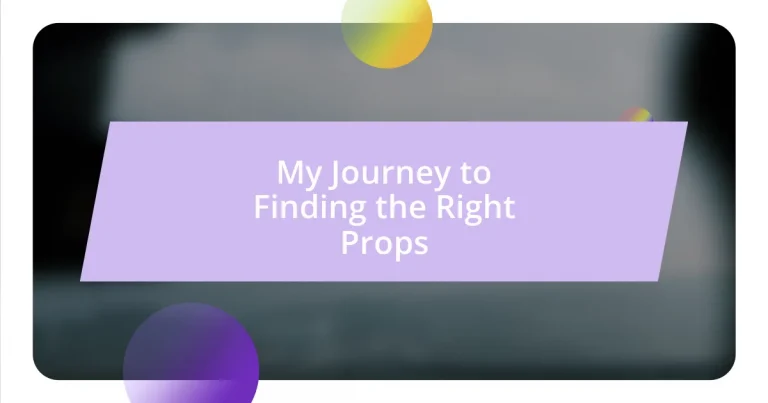Key takeaways:
- Props are vital for storytelling, enriching characters’ narratives and evoking emotions in the audience.
- Identifying needs and goals is crucial when selecting props, considering factors like character connection, emotional impact, and budget.
- Proper organization, maintenance, and sourcing from trusted suppliers enhance the effectiveness and quality of props in creative projects.

Understanding the Importance of Props
Props serve as the visual storytellers in any production, enhancing the narrative and anchoring the audience’s engagement. I remember the first time I used an old, weathered suitcase as a prop in a scene; it wasn’t just a piece of set decoration. It added layers to the character’s backstory, allowing the audience to feel the weight of their journey with every glance.
Many might wonder, how can something seemingly simple spark such deep emotional connections? In my experience, the right props can evoke feelings of nostalgia, excitement, or even tension. For example, a fragile, broken toy can instantly communicate a sense of loss, shaping the mood of the entire scene. It’s fascinating how an object can carry so much meaning.
Ultimately, props are more than just accessories; they are essential tools for expression and immersion. When I held that suitcase during rehearsal, it wasn’t just a prop. It became a bridge connecting me to my character’s struggles, a tangible reminder of how far we’ve come and what we’ve left behind. How often do we overlook the power of these small details that can shift a story’s emotional landscape? It’s a subtle art I’ve come to appreciate deeply.

Identifying Your Needs and Goals
Identifying your needs and goals is the first crucial step in choosing the right props. I often find that clarifying my vision before I start searching helps me narrow down the options and zero in on what truly resonates with the emotion I want to convey. For instance, I once struggled with finding a prop for a scene that needed to depict a character’s isolation. It wasn’t until I sat down and wrote out my character’s journey that I realized a simple, worn-out chair could symbolize their loneliness beautifully.
Here are a few things to consider when identifying your needs and goals for props:
- Character Connection: Think about how the prop relates to your character’s story. Does it enhance their background or current state?
- Emotional Impact: Reflect on the feelings you aim to evoke in your audience. What emotions should the props stir?
- Scene Context: Consider the setting and tone of your scene. Will the props blend organically into the narrative?
- Budget: Set a practical budget based on what you genuinely need. Sometimes less is more, and creativity can fill the gaps.
- Functionality: Ensure that the prop not only looks good but serves a purpose within the scene, adding to the storytelling, not detracting from it.
By prioritizing these factors, I’ve found that my prop choices become much more intentional and impactful.

Researching Prop Options Available
Researching props can feel overwhelming, especially with the myriad of options available. In my own journey, I discovered that starting with online platforms can be a goldmine. Websites like Etsy and specialized prop rental services often house unique pieces that you wouldn’t typically find in stores. I remember once stumbling across a vintage typewriter that perfectly captured the essence of a writer’s struggle. The moment I laid eyes on it, I knew it was the missing piece to fully flesh out my character’s story.
As you delve into your search, considering local thrift shops and flea markets can yield hidden gems as well. I still recall a particular trip where I found an exquisite antique mirror. Not only did it fit the aesthetic of my production, but it also symbolized the character’s self-reflection and personal growth. Each time I walked past that mirror during rehearsals, it reminded me of how crucial it is to keep an open mind while exploring different sources for props.
I think sharing ideas with peers can significantly enhance your research process. Participating in online forums or social media groups dedicated to set design and prop sourcing opened my eyes to options I never thought to explore. Collaboration not only helps you gather input but often sparks creativity in choosing props that tell your story more effectively.
| Source | Type of Props |
|---|---|
| Online Platforms (e.g., Etsy) | Unique and Vintage |
| Local Thrift Shops | Antiques and Budget Finds |
| Prop Rental Services | Professional Sets |
| Flea Markets | Eclectic and Diverse |
| Peer Recommendations | Creative Insights |

Evaluating Quality and Affordability
When evaluating quality and affordability, I’ve learned to look closely at the materials used in the props. Sometimes, a lower price tag comes with lower durability, which could mean spending more in the long run if items need replacing. I remember a time I purchased an inexpensive backdrop that frayed after just a few uses; it taught me that investing a little more initially for something well-made can save heartache—and money—down the line.
Additionally, it’s important to consider how the prop fits into the overall budget. Have you ever been tempted by a stunning piece at a premium price? I know I have. Balancing between personal aesthetic desires and actual budget constraints can be tricky. What I’ve found is that sometimes I can sacrifice certain luxuries for something that offers greater versatility, allowing it to be reused in different contexts across various projects.
Finally, don’t underestimate the power of asking for samples or examining props in person whenever possible. I recall taking a trip to a prop house and being able to touch and interact with different pieces. This tactile experience made all the difference. It’s not just about what looks good in photos; it’s also about how it feels to handle the props and whether they meet the practical needs of your project. So, the next time you’re scouting for props, remember that quality and affordability can coexist—you just have to dig a little deeper.

Testing Props Before Committing
Before committing to a prop, I’ve found that it’s essential to test it in a real-world context. One time, I brought a chair to a rehearsal that looked fantastic but proved uncomfortable for actors trying to perform. Can you imagine their struggle during a heartfelt scene? It emphasized the need to ensure each piece not only fits aesthetically but also functions well for its intended purpose.
Another strategy I’ve adopted is creating a small set-up at home to see how props interact with one another. I remember arranging a few items on my living room table to visualize how they would appear on stage. I was surprised by how a simple tablecloth transformed the entire look. Have you ever experienced a prop changing your perspective on a scene? For me, that little setup was a mini revelation. It taught me that the magic often lies in the details and arrangements.
Finally, I encourage you to consider the emotional impact of each prop during your testing phase. Does that vintage clock resonate with the theme of time slipping away in your narrative? Every time I’ve managed to test a prop’s synergy with the storyline, the connection becomes clearer. This practice has profoundly influenced my decision-making process. It’s not just about finding the right prop; it’s about finding the one that echoes the story you want to tell.

Sourcing Props from Trusted Suppliers
Sourcing props from trusted suppliers is crucial in ensuring the quality and authenticity of your project. I remember when I decided to explore different suppliers to find the perfect vintage items for a themed event. I reached out to a few local antique stores, building relationships with the owners, which not only provided me with unique finds but also insights into their history and significance. Have you ever felt that thrill of connecting with a supplier who truly understands your vision? It makes the sourcing process not just transactional but enriching.
Another key aspect I’ve learned is to rely on reviews and recommendations. I often consult online forums and social media groups dedicated to prop sourcing, where other creatives share their experiences. One day, I stumbled upon a supplier that was highly praised for their impeccable customer service. Sure enough, my experience mirrored those glowing reviews when I needed assistance in selecting the right size and color for a prop. I think it’s vital to trust the community’s voice; experience shared by others can guide you to reliable sources.
Finally, I emphasize the importance of establishing clear communication with suppliers. I recall a project where I needed last-minute adjustments, and my supplier was not only accommodating but suggested alternatives that improved the overall aesthetic. Their willingness to collaborate made all the difference. Have you ever faced a roadblock that was resolved through effective dialogue? It reinforces my belief that successful sourcing is about partnership—working together to elevate your creative vision.

Maintaining and Organizing Your Props
Storing and organizing props can be a game-changer in any creative project. I remember when I first started accumulating various items—a mix of what I’d found and what I’d sourced—my room became an overwhelming maze. To tackle this, I adopted a system where I categorized props by type and purpose. For instance, having a dedicated box for kitchenware and another for vintage accessories not only made finding what I needed easier but also sparked inspiration when I stumbled upon an item simply waiting for its moment.
In my experience, labeling is key. I took a few afternoons to label each bin with clear descriptions and even included a photo of the contents. Did you know that having visuals can trigger your memory? It certainly did for me! Now, I glance at a simples label, and it instantly reminds me of the project it belongs to. This little effort has saved me countless hours of searching, allowing me to stay creative rather than feeling bogged down by clutter.
Another tip I’ve picked up along the way is to maintain a regular inventory check. I try to review my collection at the start of each new project season. This practice helps me reassess what I have, what I may need, and even what might need to be retired. Have you ever discovered an old prop that sparked a new idea? I certainly have! It’s fascinating how a simple refresh of your inventory can open doors to innovative possibilities, keeping the creative juices flowing and ensuring your props remain organized and functional.














